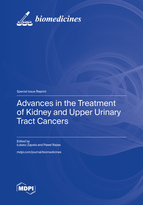Advances in the Treatment of Kidney and Upper Urinary Tract Cancers
A special issue of Biomedicines (ISSN 2227-9059). This special issue belongs to the section "Cancer Biology and Oncology".
Deadline for manuscript submissions: closed (31 December 2023) | Viewed by 13802
Special Issue Editors
Interests: non-muscle invasive bladder cancer
Special Issues, Collections and Topics in MDPI journals
Special Issue Information
Dear Colleagues,
Kidney and Upper Tract Urinary Cancers (UTUC) are diseases of increasing population coverage, the treatment of which are undergoing a continuous process of evolution. A characteristic feature of the picture composing the results of renal cell cancer (RCC) treatment is the significant heterogeneity of patients (including different stages of local advancement, different locations of metastases). Importantly, it is estimated that up to 30% of newly diagnosed RCC cases are patients with disseminated disease at the time of diagnosis. Therefore, predicting the response to modern treatment remains the unmet need of modern urologic oncology. Recent advancements in systematic treatment, i.e., immunotherapy, shed additional light on adjuvant treatment to be implemented in new clinical scenarios, including localized disease.
This Special Issue aims to cover novel approaches in the renal and urothelial cancers. We opt for original papers and reviews relating to advances in the treatment of Kidney and Upper Tract Urinary Cancers.
Dr. Łukasz Zapała
Dr. Pawel Rajwa
Guest Editors
Manuscript Submission Information
Manuscripts should be submitted online at www.mdpi.com by registering and logging in to this website. Once you are registered, click here to go to the submission form. Manuscripts can be submitted until the deadline. All submissions that pass pre-check are peer-reviewed. Accepted papers will be published continuously in the journal (as soon as accepted) and will be listed together on the special issue website. Research articles, review articles as well as short communications are invited. For planned papers, a title and short abstract (about 100 words) can be sent to the Editorial Office for announcement on this website.
Submitted manuscripts should not have been published previously, nor be under consideration for publication elsewhere (except conference proceedings papers). All manuscripts are thoroughly refereed through a single-blind peer-review process. A guide for authors and other relevant information for submission of manuscripts is available on the Instructions for Authors page. Biomedicines is an international peer-reviewed open access monthly journal published by MDPI.
Please visit the Instructions for Authors page before submitting a manuscript. The Article Processing Charge (APC) for publication in this open access journal is 2600 CHF (Swiss Francs). Submitted papers should be well formatted and use good English. Authors may use MDPI's English editing service prior to publication or during author revisions.
Keywords
- renal cancer
- urothelial cancer
- immunotherapy
- systemic therapy







